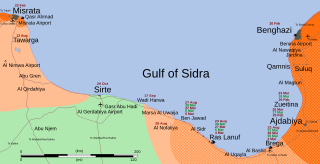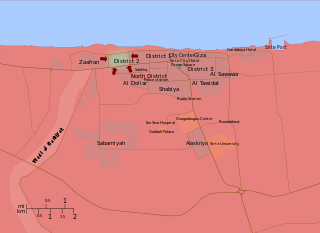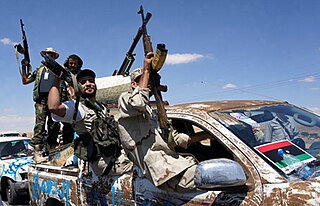
The battle of Misrata, also known as the siege of Misrata, was a battle of the 2011 Libyan Civil War for the control of Misrata. It was fought between troops loyal to the government of Muammar Gaddafi, and anti-Gaddafi rebels who held Misrata, the third largest city in Libya. Following the initial stages of the uprising, the Libyan government took back most towns in the west of the country, leaving Misrata the only major city under rebel control in Tripolitania. The city soon became the site of one of the war's major battles and the suffering of its citizens gained worldwide attention.

The Libyan Civil War began on 17 February 2011 as a civil protest and later evolved into a widespread uprising. By mid-August, anti-Gaddafi forces effectively supported by a NATO-led international coalition were ascendant in Tripolitania, breaking out of the restive Nafusa Mountains in the south to mount an offensive toward the coast and advancing from Misrata on loyalist-held cities and villages from the north and east.

The First Battle of Brega was fought during the Libyan Civil War. It began when pro-Gaddafi government troops attacked the city, held by the National Transitional Council, in the early hours of 2 March 2011.
The Battle of Ras Lanuf was a two-phase battle in 2011 during the Libyan Civil War between forces loyal to Libyan leader Muammar Gaddafi and those loyal to the National Transitional Council. Both forces sought control of the town of Ras Lanuf. The first phase followed two days after the First Battle of Brega which occurred in the town Brega, roughly 130 kilometres (81 mi) to the east of Ras Lanuf. After conquering the town on 4 March, the rebels pushed further west to attack Sirte but they were driven back by government forces and on 11 March, government troops reconquered most of Ras Lanuf.
The Nafusa Mountains campaign was a series of battles in the Libyan Civil War, fought between loyalist pro-Gaddafi forces and rebel anti-Gaddafi forces in the Nafusa Mountains and, at a later period, in the surrounding plains of western Libya. The mountain range is of strategic importance due to its close proximity to the capital of Tripoli. Along with the city of Misrata, the Nafusa Mountains region was one of the major rebel strongholds in Tripolitania.
The Battle of Wazzin was a conflict during the Libyan Civil War for the Libyan-Tunisian border town of Wazzin. Rebel forces made an initial victory, but it was short-lived as Gaddafi's men re-occupied the town, only to lose it again to the rebels.
The Cyrenaican desert campaign was a military campaign conducted by the Libyan military in the form of hit-and-run attacks against rebel-held towns and oil facilities in the eastern Libyan Desert that began in April 2011, during the Libyan Civil War. The campaign failed in denying anti-Gaddafi forces control of southern Cyrenaica.
The Second Battle of Zawiya or Zawia took place during the Libyan Civil War between rebel anti-Gaddafi forces and forces loyal to Muammar Gaddafi for control of the Tripolitanian city of Zawia.

The timeline of the Libyan civil war begins on 15 February 2011 and ends on 20 October 2011. The conflict began with a series of peaceful protests, similar to others of the Arab Spring, later becoming a full-scale civil war between the forces loyal to Muammar Gaddafi's government and the anti-Gaddafi forces. The conflict can roughly be divided into two periods before and after external military intervention authorized by United Nations Security Council Resolution 1973.
The First Battle of Zawiya or Zawia was a battle during the Libyan Civil War between army units and militiamen loyal to Muammar Gaddafi and anti-Gaddafi forces for control of the city of Zawia.
The 2011 Libyan rebel coastal offensive was a major rebel offensive of the Libyan Civil War. It was mounted by anti-Gaddafi forces with the intention of cutting off the supply route from Tunisia for pro-Gaddafi loyalist forces in Tripoli.
The Zliten uprising was a local uprising in the Libyan Civil War, started by rebel anti-Gaddafi forces against loyalist pro-Gaddafi forces in the city of Zliten. The city was of strategic importance due to its close proximity to the capital of Tripoli. After Zliten, only two cities – Khoms and Tajura – separated the rebel stronghold of Misrata from Tripoli.

The Libyan Civil War began on 15 February 2011 as a civil protest and later evolved into a widespread uprising. However, by 19 March, Libyan forces under Colonel Muammar Gaddafi were on the brink of a decisive victory over rebels in Libya's east. That day, leading NATO members acted on United Nations Security Council Resolution 1973 which authorized member states "to take all necessary measures... to protect civilians and civilian populated areas under threat of attack in the Libyan Arab Jamahiriya, including Benghazi, while excluding an occupation force".
The 2011 Ras Ajdir clashes were a series of skirmishes between rebel anti-Gaddafi forces and loyalist pro-Gaddafi forces for an important Libya–Tunisia border post in Libya's extreme northwest.

The Second Gulf of Sidra offensive was a military operation in the First Libyan Civil War conducted by rebel anti-Gaddafi forces in August and September 2011 to take control of towns along the Gulf of Sidra in an effort to surround Muammar Gaddafi's hometown of Sirte, which was held by pro-Gaddafi forces. It ended on 20 October, with the capture and execution of Muammar Gaddafi and his son Mutassim Gaddafi, along with former defense minister Abu-Bakr Yunis Jabr. The Gaddafi loyalists in the area were finally defeated when NTC fighters captured Sirte.

The Battle of Sirte was the final and most decisive battle of the First Libyan Civil War, beginning when the National Liberation Army attacked the last remnants of the Libyan army still loyal to Muammar Gaddafi in his hometown and designated capital of Sirte, on the Gulf of Sidra. As of September 2011, Sirte and Bani Walid were the last strongholds of Gaddafi loyalists and the National Transitional Council hoped that the fall of Sirte would bring the war to an end. The battle and its aftermath marked the final collapse of the four-decade Gaddafi regime. Both Gaddafi and his son, Mutassim, were wounded and captured, then tortured and killed in custody less than an hour later. The month-long battle left Sirte almost completely in ruins, with many buildings damaged or totally destroyed.

The Battle of Bani Walid was a military operation in the Libyan Civil War conducted by anti-Gaddafi forces in September and October 2011, in an effort to take control of the desert city of Bani Walid from pro-Gaddafi forces. It began following days of force buildup on the part of the attackers, as well as skirmishes around the city.
The raid on Ghadames was a series of hit-and-run attacks carried out between 24 and 26 September 2011 by groups of pro-Gaddafi forces, allegedly including elements of the Khamis Brigade, against the National Transitional Council-administered desert oasis town of Ghadames, Libya, during the Libyan Civil War.

The 2011 Libyan Civil War began on 17 February 2011 as a civil protest and later evolved into a widespread uprising. After a military intervention led by France, the United Kingdom, and the United States on 19 March turned the tide of the conflict at the Second Battle of Benghazi, anti-Gaddafi forces regrouped and established control over Misrata and most of the Nafusa Mountains in Tripolitania and much of the eastern region of Cyrenaica. In mid-May, they finally broke an extended siege of Misrata.
The 2012 Bani Walid uprising was an event which started on 23 January 2012 due to an incident in the city of Bani Walid in which the "May 28 Brigade" militia wished to arrest local men in unclear circumstances. The May 28 Brigade and their compound were then attacked by local fighters who then took control of the town. The incident, the combatants, and the motives of the two main belligerents — the May 28 Brigade and Brigade 93 — remain uncertain and contentious. The conflict was originally reported to be an attack by Gaddafi loyalists by local NTC officials. However, tribal leaders and residents have denied any affiliation with Gaddafi's remnants, stating their goal was the establishment of their own council in the city. Similarly Britain's Foreign Office has dismissed claims of this incident representing a pro-Gaddafi attack against the NTC, stating that this was a dispute between tribal leaders of the Warfalla tribe and the NTC.





